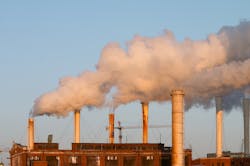Solids Handling: Don’t Overlook Orphaned Physical Properties
When I started in industry, the number of smokestacks in the area signaled prosperity. Before long, those smokestacks had to be cleaned up. Nowadays, at the end of most processes is some kind of cleanup device to control costs, protect the environment or sustain operations. Think of it as an extension of the process design. It may involve a recycling process or even the development of a new product. The operations cover all the same solids-processing steps we use in process design but often at very low concentrations of solids. This makes for a challenging situation. In air-pollution control, the particles can be sub-micron, with only a few micrograms per cubic meter allowed to be released. For water quality issues, we may draw in water for a cooling process and return it cleaner than what was received.
The number of smokestacks in the area signaled prosperity.
One of my first jobs was to build a sewage sludge incinerator. Our company was on the cutting edge of this technology, and we needed to make sure people didn’t look at our emissions as hazardous, stinky or damaging to the area. The incineration operation did a nice job of getting rid of these issues but still would have a noticeable white plume. Luckily, the plant had an excess of water after processing the sewage. We incorporated that flow into the scrubber design to cool the gas low enough to eliminate the visible plume. While regulations or expectations may change, this system was state-of-the-art in those days. Today, energy usage would be the forefront concern, but biological processes have advanced to take over that operation.
The company also had a process that made a very specialized form of fuel. It roasted the starting material to remove all contaminants without any visible emissions. The product was several million tons per year with very low emissions. However, changes in regulations required an order-of-magnitude decrease in the emission rate. An end-of-the-pipe emission control system was not feasible due to lack of water, high process temperatures and low power availability. So, we looked at several alternatives. One option was to change the process equipment, but that proved to be a dead end. A literature search uncovered a little-known characteristic of our feed material. The inorganic chemicals were in the crystalline lattice on the fault lines and accounted for most of the particulate emissions. The addition of a grinder and a fluid bed removed most of the particulate before going into the roaster. This very simple front-end addition to the process allowed the plant to reach the new emission requirements.
Many people don’t realize that solids have a vapor pressure similar to liquids. A new process had been developed for an agricultural product known to kill vegetation. The tail end of the process had a HEPA filter to prevent any of that material from leaving the plant. However, shortly after starting the operation, some dead vegetation showed up around the plant. Although the solid had a vapor pressure of less than one Torr, the particles were concentrating on one side of the filter and migrating to the other side and being released as fine particles. The addition of an adsorber that immobilized the particles solved the problem. This was not an easy problem to diagnose, especially when no liquids were involved.
I like to call these examples the “lost or orphaned physical properties” because they are simple to overlook when designing a process involving solids. It is even easier to miss these properties when we are concentrating on particulate control. Scrubbers remove particles, but their discharge can attract attention even though it may be only condensed water vapor. Fabrics (including HEPAs) are porous, but they are seldom effective by themselves on gases because of the vapor pressure, as mentioned above. Sometimes, the solution is hidden in the front end of the process. We just need to find that hidden physical property that will solve the emission problem.
The difference between design of a chemical plant and pollution control is the very small solids loading and the value of the product. Replacing the old smokestacks is considered a sustainability and compliance matter.
About the Author
Tom Blackwood, Solids Advice columnist
Contributing Editor
Tom Blackwood, a veteran engineer who has dealt extensively with solids over the course of his career, contributes regularly to Chemical Processing and serves as the Solid Advice columnist.

